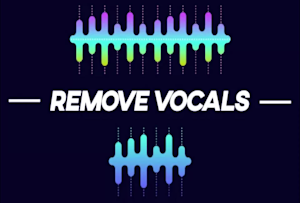Introduction to AI Vocal Remover Tools
In the ever-evolving world of music production, technology continues to transform the way artists, producers, and sound engineers create and manipulate audio. One of the most significant innovations in recent years is the AI vocal remover, a tool that uses artificial intelligence to isolate or eliminate vocals from a track. This development has opened up a wealth of creative opportunities for musicians and producers, streamlining workflows and enabling new possibilities in remixing, sampling, and practice sessions. Whether you’re a professional looking to craft new sounds or an amateur experimenting with your favorite songs, AI vocal remover tools can be a game-changer.
How AI Vocal Remover Works
AI vocal remover software uses machine learning models trained on thousands of audio samples to identify and separate the human voice from instrumental components. These tools often employ deep learning and spectrogram analysis to detect voice frequencies and distinguish them from drums, guitars, basslines, and other instruments. Once the model identifies the vocals, it can isolate them or remove them completely, leaving behind an instrumental track. This technology is remarkably accurate and continues to improve with every iteration.
The Rise of AI in Music Production
Artificial intelligence is no longer just a buzzword—it has become an integral part of modern music creation. From mastering software that analyzes audio quality to AI-powered synthesizers, the use of machine learning has reshaped studio work. The AI vocal remover fits neatly into this trend, providing a fast and efficient way to extract vocals without requiring expensive studio time or advanced audio engineering skills. It bridges the gap between professional production and amateur creativity by making complex tasks accessible to everyone.
Benefits for Music Producers
Producers benefit enormously from using an AI vocal remover. One of the most obvious advantages is the ability to create high-quality instrumental versions of any track. This is particularly useful when a producer wants to remix a song, repurpose its instrumentation, or build a completely new track around a specific beat or melody. Rather than hunting down acapella or instrumental versions online, they can generate them instantly using AI. This saves time, effort, and money.
Another key benefit is improved workflow efficiency. AI vocal remover tools eliminate the need for manual filtering and frequency adjustments, which can be time-consuming and often yield imperfect results. With AI, the separation is often near-studio quality, which allows producers to focus on creative aspects rather than technical hurdles. It empowers them to work faster and smarter.
Advantages for Musicians and Singers
For musicians and singers, the AI vocal remover is a valuable practice and performance tool. Singers can use instrumental tracks created by AI to rehearse or record their own vocals without interference. This is especially helpful for cover artists or performers preparing for live shows who need clean backing tracks. AI-generated instrumentals offer more flexibility than traditional karaoke tracks, as musicians can extract the exact version of a song they prefer, even lesser-known ones that don’t have official instrumental releases.
Instrumentalists can also benefit by isolating vocals to better understand phrasing, pitch, and emotional delivery, which can help them accompany singers more effectively. Moreover, AI vocal remover tools support creativity by encouraging experimentation. Artists can remix a familiar track, compose around its instrumental, or sample elements for new projects, all with ease.
Enhancing DJ Performances and Live Shows
DJs and live performers are increasingly turning to AI vocal remover tools to enhance their sets. By removing vocals from tracks, DJs can overlay their own vocals, mashups, or transitions without clashing with the original song’s lyrics. This allows for more dynamic and customized performances. It also empowers DJs to remix tracks on the fly, tailoring their sets to fit the vibe of the audience and venue. In live settings, performers can use instrumental versions as backing for live vocals, offering a richer and more flexible show.
Educational Applications
AI vocal remover software is also finding a place in music education. Teachers and students alike can use it to dissect and study songs in detail. For instance, a vocal coach might isolate the singer’s voice to analyze breathing techniques, vibrato, and articulation. A music student could remove vocals to focus on instrumental arrangement, chord progression, or rhythm. This kind of analytical listening was once reserved for professionals with access to multitrack recordings, but AI has made it available to everyone.
Legal and Ethical Considerations
While the advantages of AI vocal remover tools are clear, it’s important to consider the legal and ethical implications. Using vocal-removed tracks for commercial purposes can raise copyright issues if proper licensing is not obtained. Artists should always ensure they are using tracks legally, particularly when distributing or monetizing their creations. That said, for personal use, practice, and educational purposes, these tools offer a fair and valuable way to interact with music. Many AI vocal remover platforms also respect intellectual property by offering watermark-free options for licensed users.
Top AI Vocal Remover Tools on the Market
Several high-quality AI vocal remover tools are available today, both free and paid. Tools like Spleeter, Moises.ai, PhonicMind, and Lalal.ai are known for their accuracy, speed, and user-friendly interfaces. These platforms offer cloud-based or downloadable options and support various audio formats. Many even allow for advanced control, such as adjusting the volume of vocals versus instruments or isolating specific stems like drums and bass. With growing competition, these tools are becoming more affordable and powerful, making them accessible to all levels of musicians.
Limitations and Challenges
Despite their many benefits, AI vocal remover tools are not without limitations. The quality of the vocal removal depends heavily on the complexity of the song and the mix. Tracks with heavy reverb, overlapping frequencies, or unusual instrumentation may result in artifacts or loss of quality. While AI is improving, it is not perfect. Users should be prepared for occasional imperfections and consider using equalization or post-processing tools to refine the results. However, for most purposes, especially non-commercial use, the quality is more than sufficient.
Future of AI in Audio Editing
The future of AI in music is incredibly promising. As machine learning models become more advanced, we can expect even greater precision in vocal removal, real-time separation, and adaptive remixing features. Some platforms are already integrating voice synthesis and pitch correction alongside vocal separation, offering an all-in-one creative suite. AI will likely continue to blur the lines between professional and amateur music production, empowering more creators to bring their ideas to life with fewer barriers.
Conclusion
The ai vocal remover represents a major leap forward in the democratization of music production. By giving musicians, producers, DJs, and educators the ability to separate vocals with just a few clicks, this technology has changed the way we interact with music. It saves time, enhances creativity, and makes previously complex audio manipulation accessible to anyone with a computer or smartphone. While users must navigate its limitations and use it responsibly, there’s no denying that AI vocal remover tools are here to stay—and their potential is only just beginning to be realized.
Ask ChatGPT


